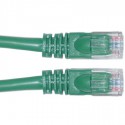Augmented Category 6 Cat6a cable is the new cabling standard. Category 6a cable are fully backward
compatible with all the previous categories, including Category 6 and 5e.
Cables4sure Cat6a Cables have been specifically design to support easy installation, reduced cross
talk at the same time having minimal impact on the on the environment with the outer cable diminsions
being similar in profile to Cat6 Cables.
Cat6a cable designed for Gigabit Ethernet and other standard network protocols, so they can handle
10BASE-T, 100BASE-TX, 1000BASE-TX, and 10GBASE-T.
Category 6 cable
From Wikipedia, the free encyclopedia
Category 6 cable, commonly referred to as Cat 6, is a standardized cable for Gigabit Ethernet and
other network physical layers that is backward compatible with the Category 5/5e and Category 3
cable standards. Compared with Cat 5 and Cat 5e, Cat 6 features more stringent
specifications for crosstalk and system noise.[citation needed] The cable standard provides
performance of up to 250 MHz and is suitable for 10BASE-T, 100BASE-TX (Fast Ethernet),
1000BASE-T/1000BASE-TX (Gigabit Ethernet) and 10GBASE-T (10-Gigabit Ethernet).
Whereas Category 6 cable has a reduced maximum length when used for 10GBASE-T; Category 6a cable,
or Augmented Category 6, is characterized to 500 MHz and has improved alien crosstalk characteristics,
allowing 10GBASE-T to be run for the same distance as previous protocols.
The heavier wire in some Cat 6 cables makes them too thick to attach to standard 8P8C connectors
without a special modular piece, resulting in a technically out-of-compliance assembly.
Because the conductor sizes are generally the same, Cat 6 jacks may also be used with Cat 5e cable.
Category 6 cable can be identified by the printing on the side of the cable sheath.
Cat 6 patch cables are normally terminated in 8P8C modular connectors. If Cat 6 rated patch cables,
jacks, and connectors are not used with Cat 6 wiring, overall performance is degraded to that of the
cable or connector.
Connectors use either T568A or T568B pin assignments; although performance is comparable provided both
ends of a cable are the same, T568B is a deprecated standard in the US and no longer supported by TIA.
Category 6a
The latest standard from the TIA for enhanced performance standards for twisted pair cable systems was
defined in February 2008 in ANSI/TIA/EIA-568-B.2-10. Category 6a (or Augmented Category 6) is defined
at frequencies up to 500 MHz—twice that of Cat. 6.
Category 6a performs at improved specifications, in particular in the area of alien crosstalk as
compared to Cat 6 UTP (unshielded twisted pair), which exhibited high alien noise in high frequencies.
The global cabling standard ISO/IEC 11801 has been extended by the addition of amendment 2.
This amendment defines new specifications for Cat. 6A components and Class EA permanent links.
These new global Cat. 6A/Class EA specifications require a new generation of connecting hardware
offering far superior performance compared to the existing products that are based on the American TIA
standard.
The most important point is a performance difference between ISO/IEC and EIA/TIA component
specifications for the NEXT transmission parameter. At a frequency of 500 MHz, an ISO/IEC Cat.
6A connector performs 3 dB better than a Cat. 6A connector that conforms with the EIA/TIA specification.
3 dB equals 50% reduction of near-end crosstalk noise signal power; see 3dB-point.
Confusion therefore arises because of the different naming conventions and performance benchmarks laid
down by the International ISO/IEC and American TIA/EIA standards, which in turn are different from the
regional European standard, EN 50173-1. In broad terms, the ISO standard for Cat6A is the highest,
followed by the European standard and then the American(1 on 1 matching capability).[3][4]
Maximum length
When used for 10/100/1000BASE-T, the maximum allowed length of a Cat 6 cable is 100 meters or 328 feet.
This consists of 90 meters (300 ft) of solid "horizontal" cabling between the patch panel and the wall
jack, plus 10 meters (33 ft) of stranded patch cable between each jack and the attached device. Since
stranded cable has higher attenuation than solid cable, exceeding 10 metres of patch cabling will
reduce the permissible length of horizontal cable.
When used for 10GBASE-T, Cat 6 cable's maximum length is 55 meters (180 ft) in a favourable alien
crosstalk environment, but only 37 meters (121 ft) in a hostile alien crosstalk environment, such as
when many cables are bundled together. However, because the effects of alien crosstalk environments on
cables are difficult to determine prior to installation, it is highly recommended that all Cat6 cables
being used for 10GBASE-T are electrically tested once installed. With its improved specifications,
Cat6A does not have this limitation and can run 10GBASE-T at 100 meters (330 ft) without electronic
testing.
Category 6 and 6a cable must be properly installed and terminated to meet specifications. The cable
must not be kinked or bent too tightly (the bend radius should be at least four times the outer
diameter of the cable[5]). The wire pairs must not be untwisted and the outer jacket must not be
stripped back more than 1/2 inch (1.27 cm).
All shielded cables must be grounded for safety and effectiveness and a continuous shield connection
maintained from end to end.[6] Ground loops develop when there is more than one ground connection and
the difference in common mode voltage potential at these ground connections introduces noise into the
cabling.


